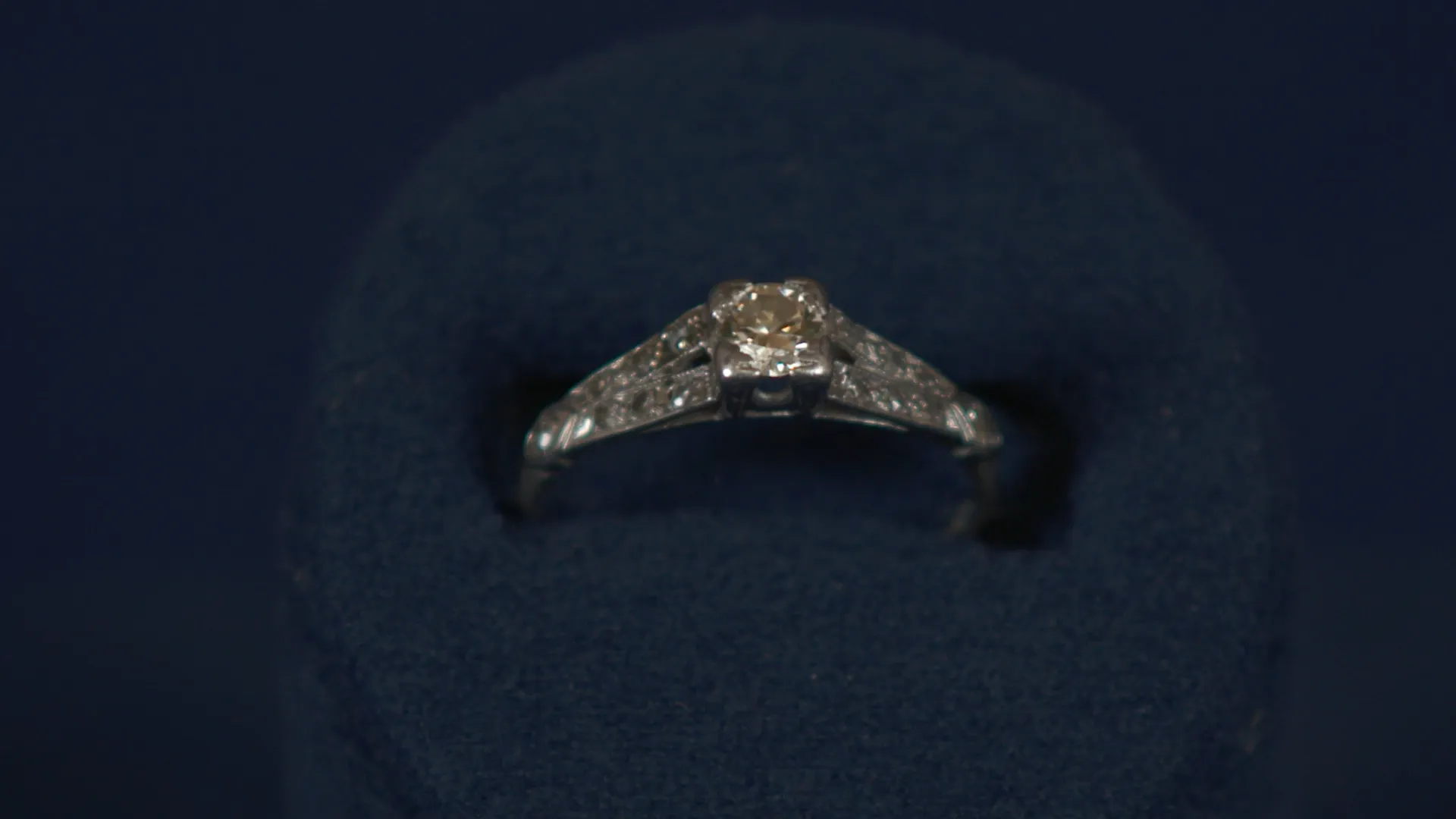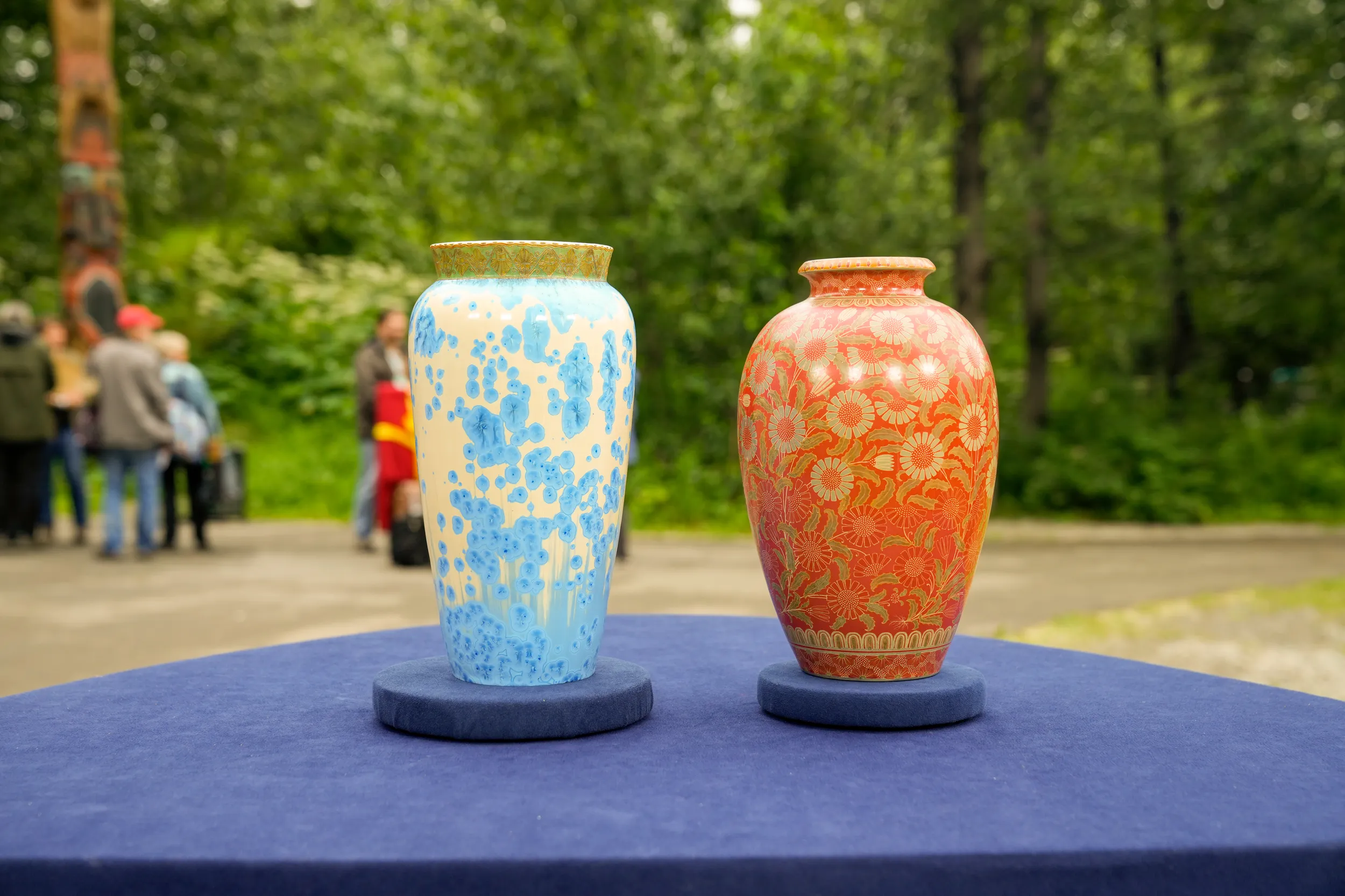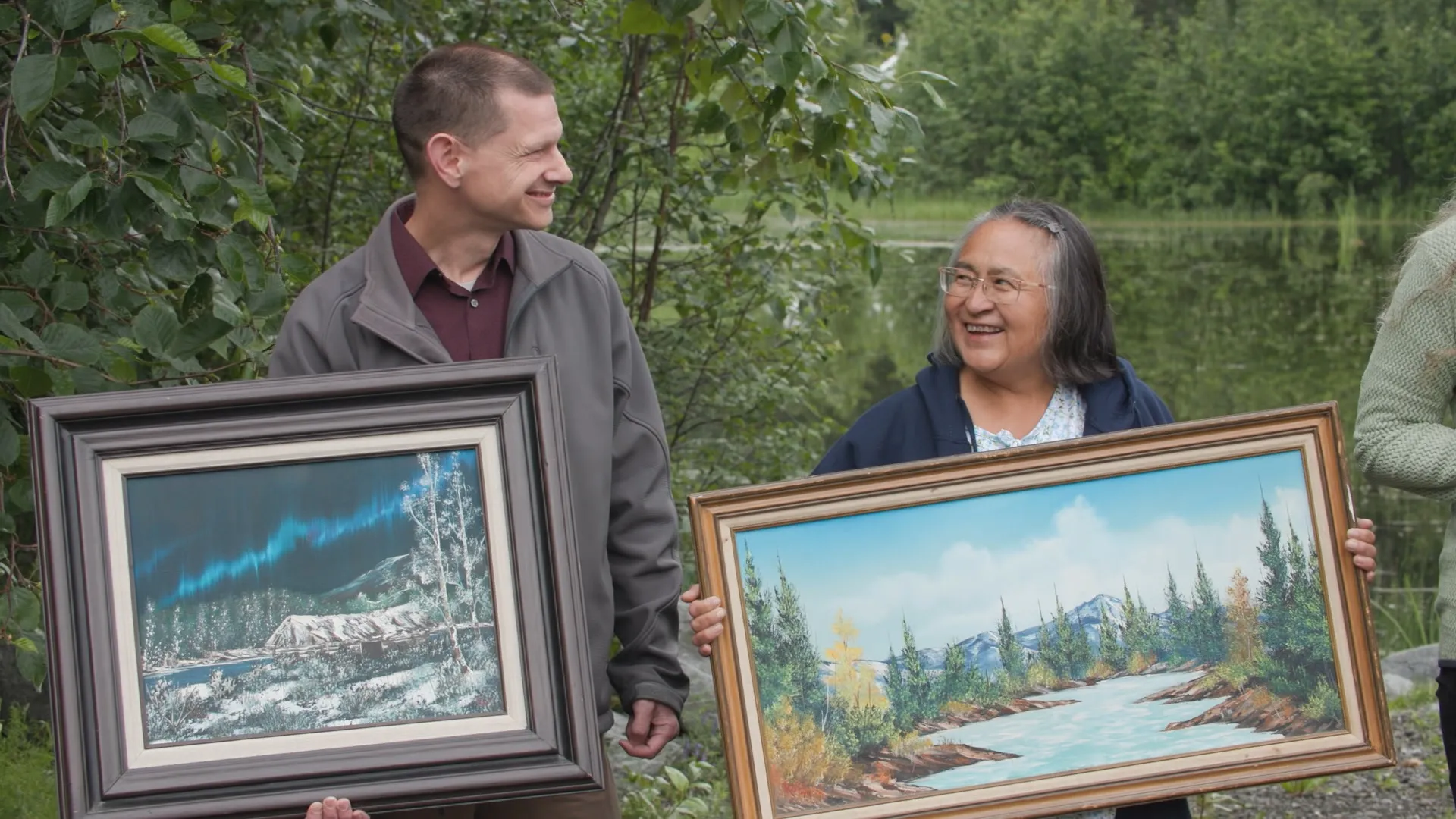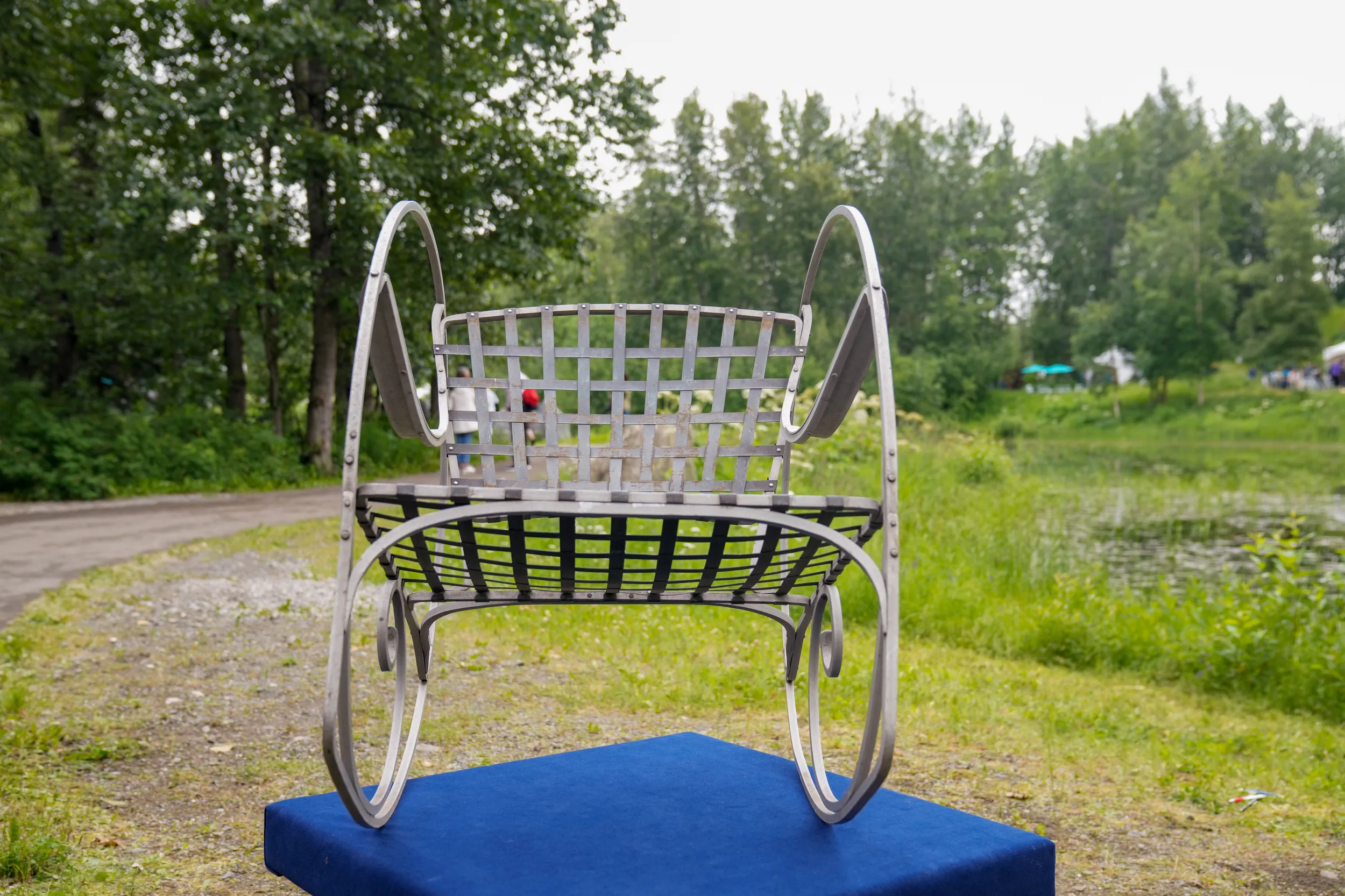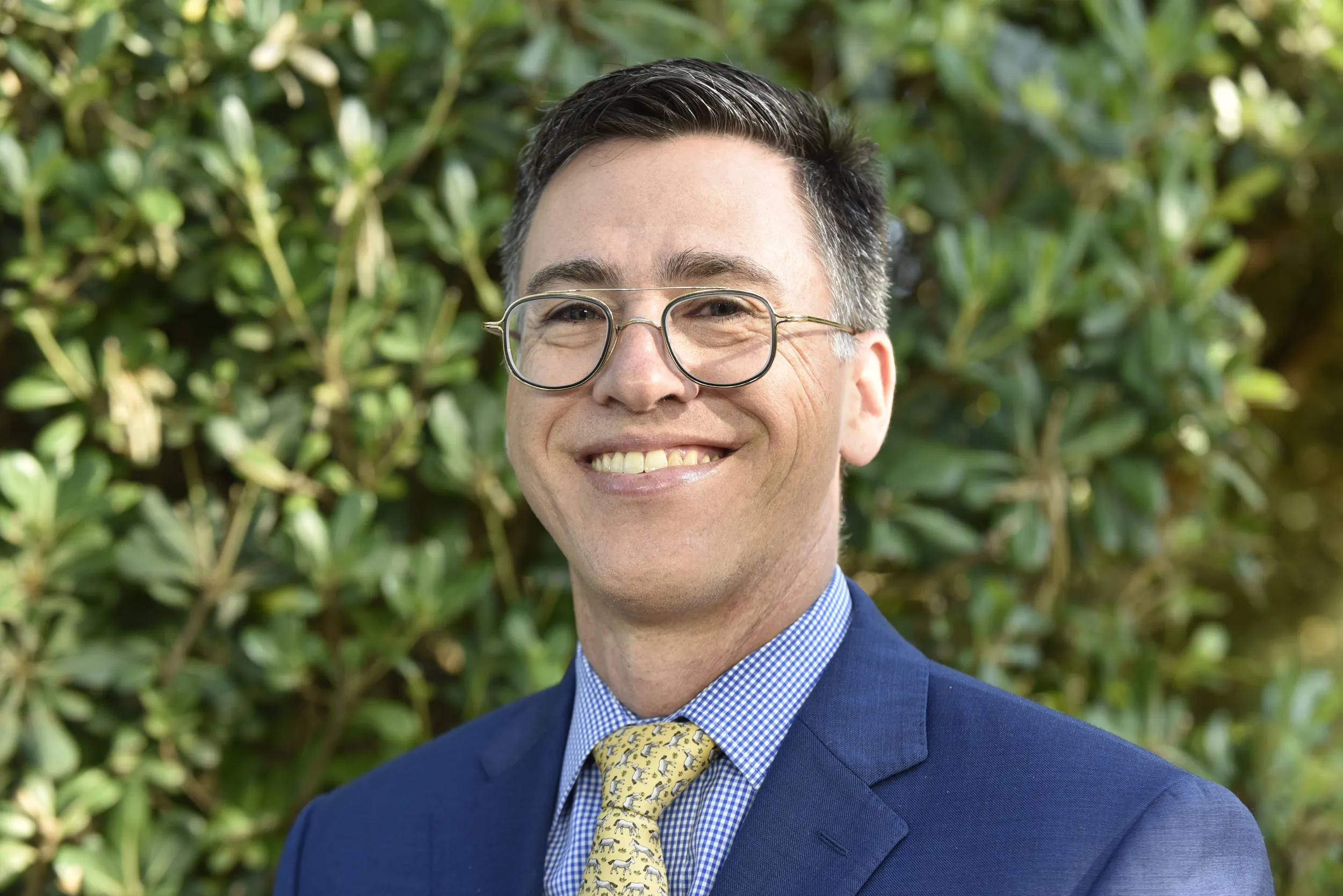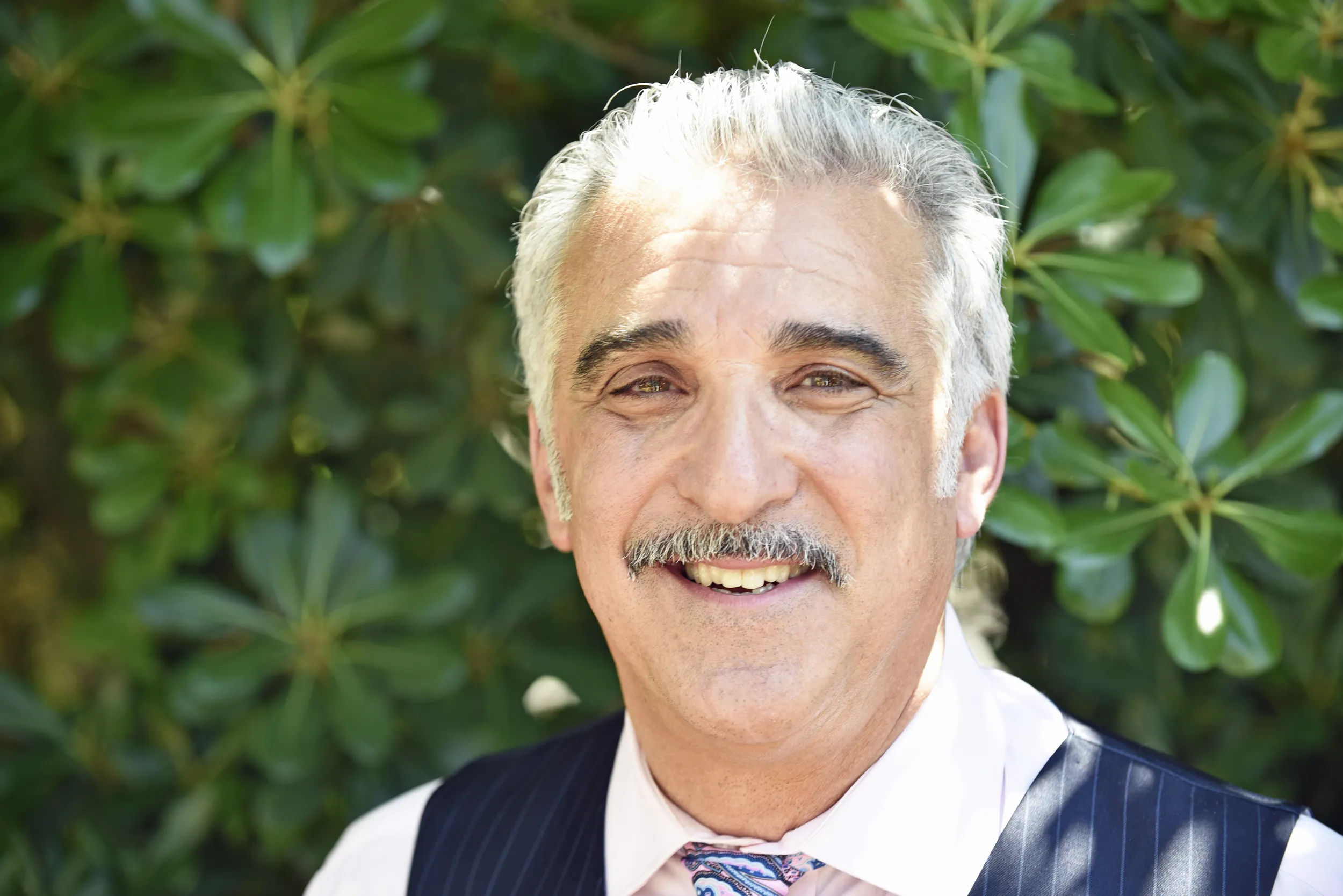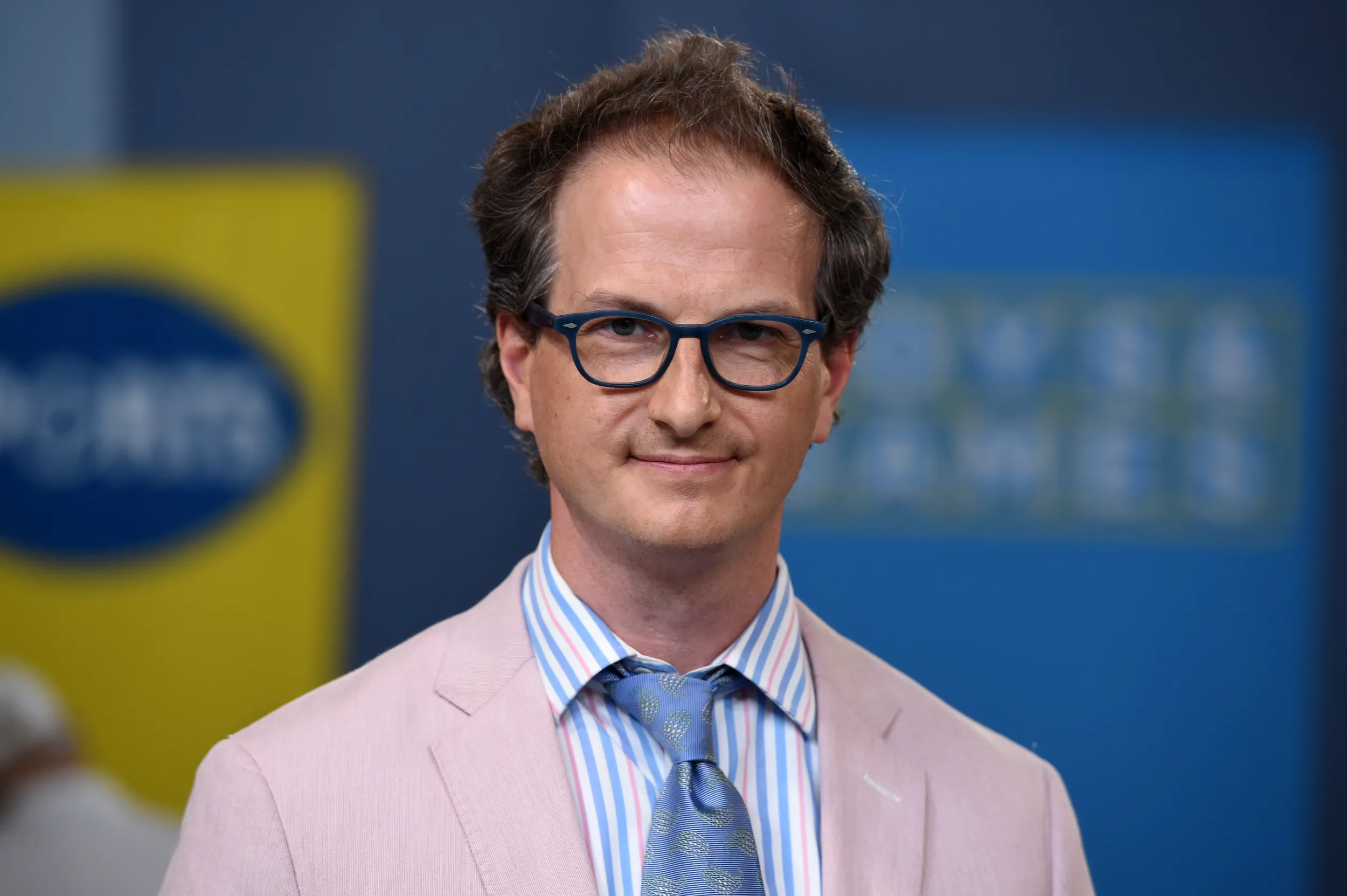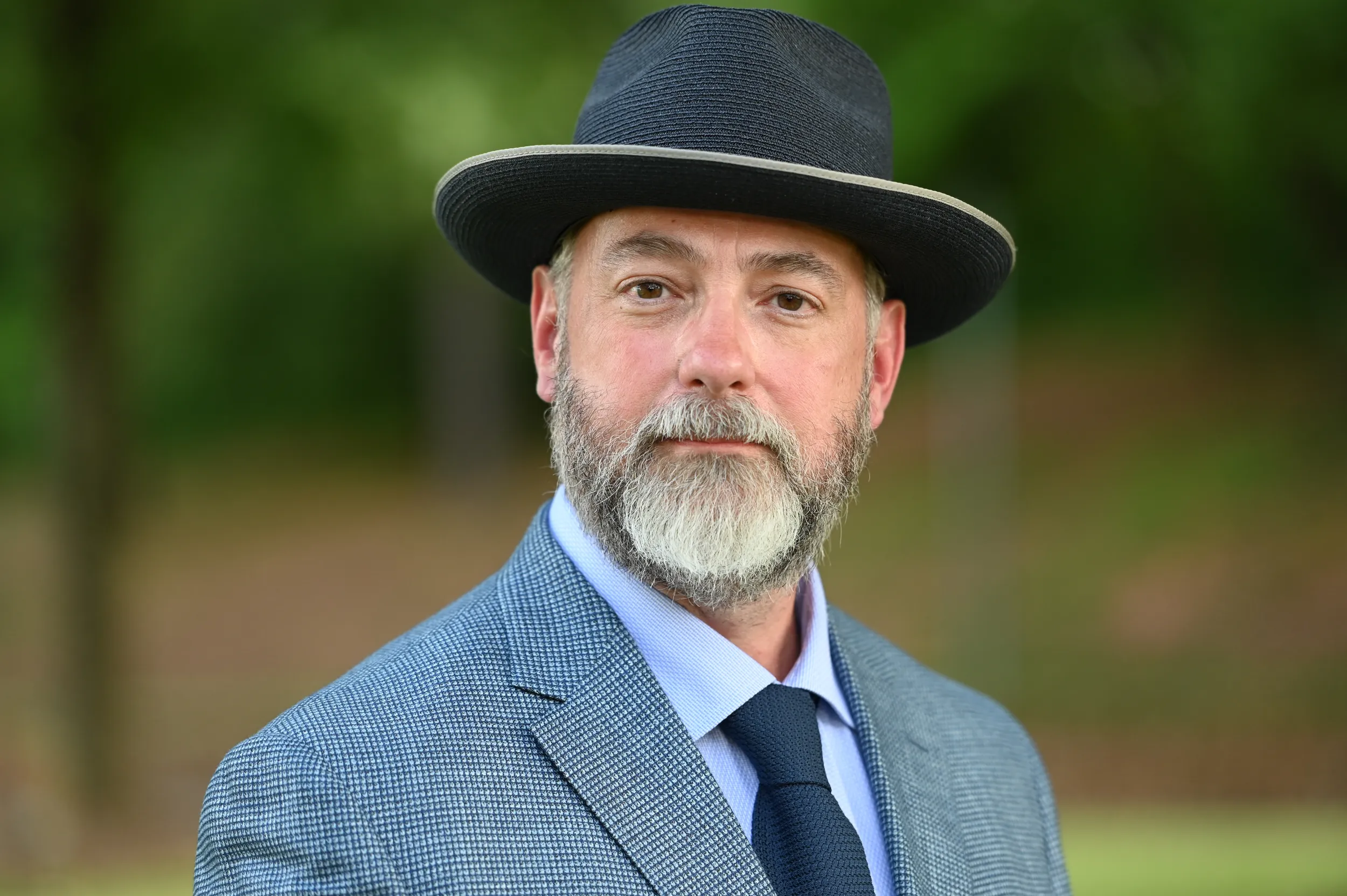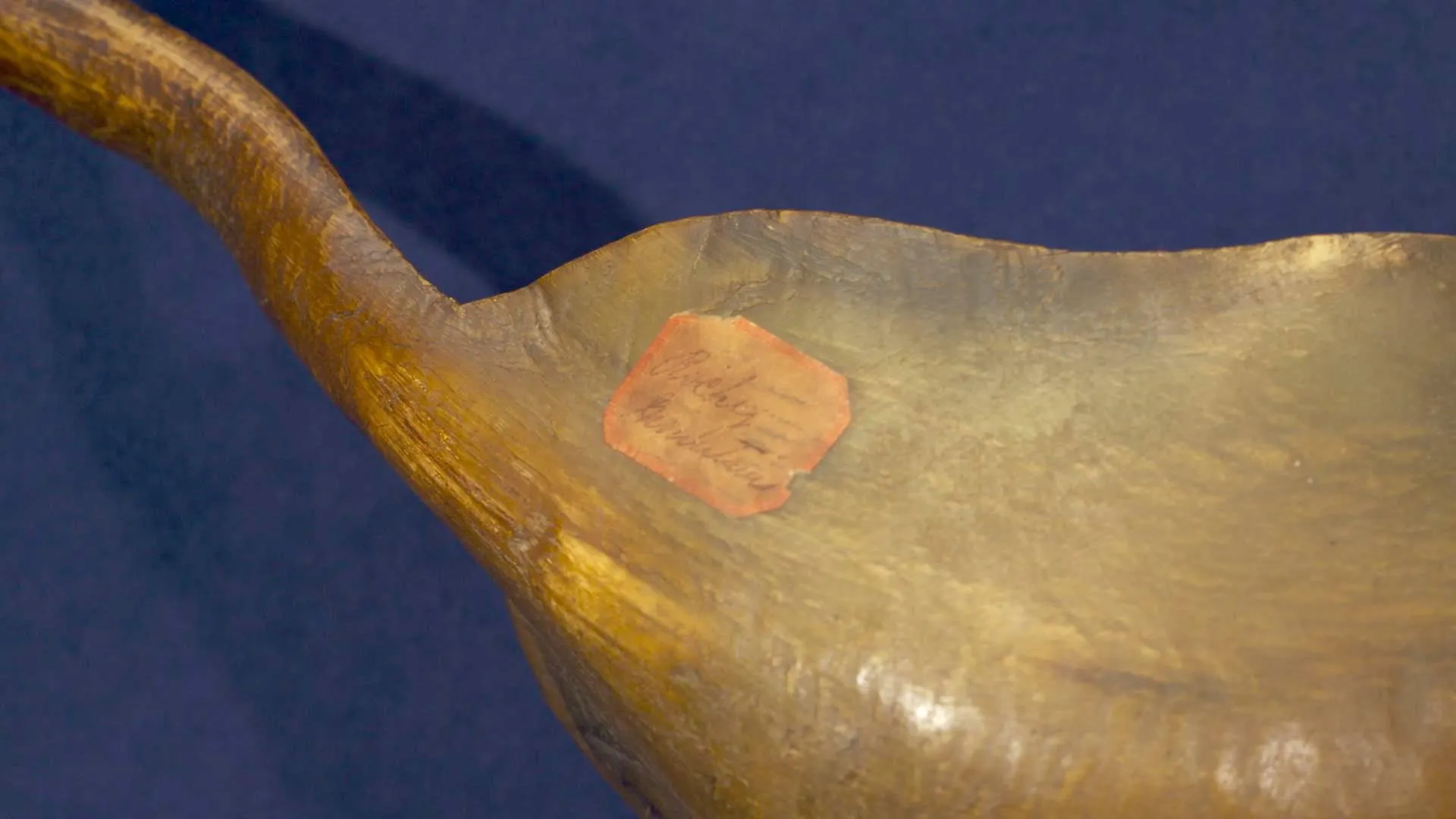HOST: The Alaska Native Heritage Center is welcoming ROADSHOW on our first-ever visit to Alaska.
APPRAISER: This is bling before the word existed.
APPRAISER: He's like this mix of John Muir and Rambo.
GUEST: That's crazy.
HOST: The Alaska Native Heritage Center honors the traditions and histories of Indigenous peoples from all across the state. This 30-foot-tall totem pole, carved by Tlingit artist Nathan Jackson, is called Kooteeyaa: Opening the Box of Wisdom. The top figure represents the clan leader or uncle, who holds the history of his clan. Below him is his nephew, who is opening the Box of Wisdom for future generations. On the Box of Wisdom is a human figure opening his hands to accept the knowledge being shared. And at the base of the pole, children represent both eagle and raven clans, symbolizing the inclusion of all Alaska Native cultures. There's so much to be learned about the past and present when exploring an object's history. Let's find out more about the belongings being brought to ROADSHOW today.
GUEST: This is just a 1932 Alaska license plate that I picked up at a yard sale. I paid five dollars. It was just a really cool find for me. The guy that designed the Alaska flag, Benny Benson, it's not signed, but I know it's very similar to what he was signing and giving to family members.
GUEST: This is an ice box that I found at an antique store in Lynden, Washington. $25. It looks like a jack in the box, and like a child's toy, which immediately I was attracted to. (laughs) I love color. I love the shapes of this. It made no sense to me, and it, uh, now sits in my kitchen in a place of honor. (laughs)
APPRAISER: Ok. What you brought today is this really fantastic Memphis-style ice bucket by Georges Briard. He was an American designer active in the 20th century. And the Memphis style, while it sounds like...
GUEST: Hm.
APPRAISER: ...it might have been from Tennessee, actually originated in Italy.
GUEST: Oh.
APPRAISER: And was popular in the 1980s but is experiencing a resurgence today.
GUEST: Okay.
APPRAISER: Memphis style, uh, while not super-well-known, has, uh, actually benefited from social media. And in the early 1980s, there was kind of a look back at Art Deco.
GUEST: Mm-hmm.
APPRAISER: So some of the elements of Memphis style come from looking back to the Art Deco movement in the earlier part of the 20th century.
GUEST: Mm-hmm.
APPRAISER: And it is marked on the underside. It says "designed and signed by Georges Briard." And then it was made, uh, for him, uh, at a, from a company in Japan. So it says "made in Japan."
GUEST: Oh, okay, it, made, yeah.
APPRAISER: I would insure this for $500.
GUEST: (laughs) No! That's amazing. That, wow. It's just plastic.
APPRAISER: It's just plastic, but it's fabulous plastic.
GUEST: (chuckles)
APPRAISER: So you made a really great find.
GUEST: Oh, wonderful.
GUEST: I got it at an auction, uh, two, three years ago. It's all Alaska gold and mammoth ivory, and, of course, there are some diamonds -
APPRAISER: Can I ask you what you paid for it?
GUEST: Uh, I think about $5,700.
APPRAISER: It's a belt buckle. It's rather large. Of course, I threw it on the scale.
GUEST: (laughs)
APPRAISER: You almost broke my scale.
GUEST: (laughing)
APPRAISER: There's five troy ounces of gold here. A substantial amount of gold.
GUEST: (chuckles)
APPRAISER: These nuggets, they're soldered to a base of gold. So even though it looks like they're all just laid in there, it's a lot of work and labor. You got this nice embellishment of a twist wire. I love this part, that this is mastodon tusk. Could be mammoth tusk. At first, I thought it was wood.
GUEST: Right.
APPRAISER: But tusk is such a thing in, in Alaska. All the elements here, except for the diamonds, are truly from Alaska. So then you have this beautifully executed frame, and it has nice form and shape. It's riveted on, which shows extra care that the jeweler gave it. I love the little bit of engraving on the corners. Just everywhere you look, it, it's got this beautiful little sign of quality and that somebody took care making this. Alaskan gold nuggets, on average, are around 90% pure, or...
GUEST: Yeah.
APPRAISER: ...22-karat. These deposits occur mainly in quartz, and what happens is, the, the quartz breaks off into streambeds and whatnot. And when you're panning for gold, you know, a lot of what comes up is flakes. So nuggets are a little more sought-after. Gold was discovered early on in Alaska, actually, by the Russians in the Kenai River area in 1849. And then there's more gold found in 1861.
GUEST: Mm-hmm.
APPRAISER: And then after that, you have, the city of Juneau was named after Joseph Juneau in 1880. There's a huge find of gold there. But w, w, with all this action going on, and all th, this gold discovery going on, the big one is 1896 Klondike. And that's when the frenzy really takes hold, and, and the gold rush starts, and people just start coming in. In the center, I love the fact that it has the state of Alaska. It's just so over the top.
GUEST: Mm-hmm.
APPRAISER: Approximately five carats in diamonds in the center.
GUEST: Mm-hmm.
APPRAISER: This is bling before the word existed.
GUEST: (laughs)
APPRAISER: You have any idea of maybe a time period when you think this may have, came into existence?
GUEST: Uh, probably during the pipeline days, I would think.
APPRAISER: Which is what year, roughly?
GUEST: The '70s?
APPRAISER: It's just so great. I love it-- I want to wear it.
(both laughing)
GUEST: Well, I can't wear it, I'm too fat.
(both laughing)
APPRAISER: This is so Alaskan that, in the right auction, I think something like this could be $20,000 to $40,000.
GUEST: Mm-hmm. (chuckles) That's a little more than I was thinkin’.
(both laughing)
APPRAISER: You, you got that gleam in your eye, and, you know, that, that's what gold does to people.
GUEST: (laughing)
APPRAISER: There's something about it, right?
GUEST: Well, that's for sure.
APPRAISER: Yep.
GUEST: This painting came from my grandfather, and he was born in 1902, and lived in Cincinnati his whole life. And he seemed to like this Western art. I'm thinking he bought it around 1930. Somewhere in there. It's by William Dunton. And the guy is Ben Lilly, who was a famous hunter. Killed the last bear in the Gila Wilderness, I think, the last grizzly bear. My grandfather died in the early '90s, and my parents had it since then. And then I was just back east for my dad's memorial...
APPRAISER: Uh-huh.
GUEST: ...and my mom gave it to us, and we carried it back on the plane with us.
APPRAISER: One of my favorite things about looking at paintings is often looking at the back of the paintings...
GUEST: Yeah, yup.
APPRAISER: ...because there are always interesting things to see. And when there isn't anything interesting, that's also interesting, too. But in this case, we've got a wonderful inscription and a label from the frame shop in Cincinnati where it was sold.
GUEST: Yeah.
APPRAISER: I was wondering if you might read to us this inscription.
GUEST: Certainly. It says "portrait sketch Lilly, big game hunter and scout, "age 70 years, by W. Buck Dunton, Taos, New Mexico."
APPRAISER: (chuckling): Ben Lilly was, was quite a character, as you said.
GUEST: Yeah.
APPRAISER: Who was it that he guided? It was, uh…
GUEST: Oh, Roosevelt, yeah-- yeah.
APPRAISER: Roosevelt, yeah. He's like this mix of John Muir and Rambo.
GUEST: Yeah.
APPRAISER: I mean, he is killing bears and cougars with a knife. From the reading I've done about Lilly, he didn't smoke, he didn't drink. We know his death date, December 17, 1936. If this is when he's 70, this would have been done 1925 or, or '26.
GUEST: Hm.
APPRAISER: And the artist, Buck Dunton, he didn't even get to Taos until around 1915, permanently. He didn't, he visits there in 1912.
GUEST: Hm.
APPRAISER: But he moves there in, in 1915. Lilly was already there by 1911. So when exactly they struck up a friendship, I, I don't know. But based on that inscription, it's going to be around 1925 or '26 that this was done. And at that point, Dunton is well established as one of the Taos Society of Artists and is quite successful in his own right. It makes sense that your grandfather bought it in Cincinnati, because one of his fellow society members, Sharp, in particular, had deep connections to Cincinnati, and the Taos Society of Artists were showing and selling paintings in Cincinnati. Dunton is on a "we don't know where it's going to stop" rise in value. Even though this is only seven-and-a-half by five inches, it's a little oil on canvas, it has the things we want from Dunton. It has some really beautiful color and this intense brushwork. I mean, it, it's almost like a sculpture. It's very three-dimensional. At auction today, conservatively, I would say it's worth about $12,000 to $18,000.
GUEST: Okay. Wow. Good, I'm glad it's not worth more than that.
APPRAISER: (laughs)
GUEST: (laughing): That way we can hang on to it.
HOST: When this grey whale was found on the beach at Placer River near Portage, Alaska, in 1999, the juvenile female was 41 feet long and weighed approximately 30 tons. The skeleton is now on exhibit to educate about the significance of whales to Alaska Native peoples. Whales provided food for the communities that hunted them, as well as materials to create tools, structural elements for homes, and crafts like baleen baskets.
GUEST: My husband is out of town, and I went into his comic box and pulled out these. There's about 60 more where these came from.
APPRAISER: Well, you seem like you said that with pa... "Pulled out those comic books."
GUEST: Right.
APPRAISER: What, do you want them out of the closet?
GUEST: (inhales) My husband thinks they're worth millions and billions of dollars. That's, that's his heart, right? Me, maybe a few hundred.
APPRAISER: All the books here range from the Silver Age of comics. Silver Age being about 1956 to 1970.
GUEST: Right.
APPRAISER: You have a mix of both books published by DC Comics and Marvel. You see Batman, the Hulk, Sea Devils, "Strange Tales." Any clue of which one might be better than the other?
GUEST: Well, you know, I think Green Lantern is pretty popular.
APPRAISER: Ooh, intere... Okay, you have a good eye. This is "Showcase" issue 22.
GUEST: Okay.
APPRAISER: Now, this is the first appearance of the Silver Age Green Lantern, being Hal Jordan.
GUEST: Okay.
APPRAISER: The original Green Lantern was introduced in 1940-- "All-American Comics," Alan Scott. This is the second iteration of the Green Lantern, introduced in 1959. Now, when it comes to comic books, condition is everything. It is fully ripped all the way through the spine. You have several losses along the back cover here. Staple tears, pulls. Numerically speaking, this comic is a 0.5 out of ten. It's horrible. It's the worst-conditioned comic you could ever possibly ask for.
GUSET: (laughing)
APPRAISER: But still, as a first appearance of the Silver Age Green Lantern, in this shape, as a 0.5, easily $1,000 to $1,500 today.
GUEST: (chuckling): Oh, my gosh. Fabulous!
APPRAISER: And that's just one. We haven't even tangoed with the rest of them.
GUEST: Oh, my gosh!
APPRAISER: Conservatively, uh, at auction for the collection, easily $3,000 to $5,000.
GUEST: Whoo! (laughs) I'm happy! I hope my husband can hear that.
APPRAISER: Better than $300, right?
GUEST: Right, absolutely.
APPRAISER: Yeah, there we go!
GUEST: Yeah!
GUEST: So this is actually my great-grandmother's ring. And she, um, gave it to me when I was five years old. We walked out of the house and my parents immediately took it away from me. (laughing) It had one of the diamonds, the side diamonds, missing from it. And so my mom actually had it fixed and gave it to me for my 18th birthday. When I was living on my own, I had actually been homeless once already, and I didn't want to do that again, and I wasn't going to be able to make rent. So I took everything that I had that had any kind of value, I took it to a pawn shop and I sold it outright. I didn't even pawn it, I sold it to them. When my husband and I met a while later, when he asked me to marry him, I said, "I don't want a diamond. In fact, if you buy me a diamond, I'll leave you." And I didn't tell him why. And a couple of years after we got married, I said, "You know what? "I lied, I do want a diamond, "but there's only one diamond on the whole planet that I want, and it's the one that was our family heirloom." We went back to that pawn shop, I went back in there, and there it was. And so my husband bought it back for me and it was eight years later.
APPRAISER: That is incredible.
GUEST: Yeah.
APPRAISER: That is, like, borderline miracle...
GUEST: Yes.
APPRAISER: ...is what that is. Now, when you bought it again, do you remember how much he paid for it?
GUEST: Um, about $400 was what he paid for it. I think I got about $75 for it.
APPRAISER: And do you remember how long ago it was when you bought it back?
GUEST: Um, in 2005, we bought it back. I know it's platinum and diamond. I really don't know anything other than that.
APPRAISER: Well, that is true, it is platinum and diamond, and it's in the style of the early 20th century, about the 1920s. This is from the Edwardian era, kind of moving into the Art Deco. It has some of the elements of both. It has some of the open spaces. It's platinum and diamond, which was typified by the Edwardian style, and platinum was a very new material at that time. If you go back to the Victorian era, in the late 1800s, they were, everything was made out of gold. And it was probably made somewhere on the East Coast. New York, possibly-- a lot of jewelry manufacturers there. And so that would be my best guess. We don't know exactly who made that. And in the center, we have a full-cut diamond, an old-European-cut diamond, and it weighs just short of a half of a carat. And on the sides, we have two rows of single-cut diamonds, and there's probably about another half of carat diamonds on the side.
GUEST: Okay.
APPRAISER: In total. I think in today's market, to buy this at a retail store, you'd have to pay around $1,800.
GUEST: Wow. That's a little bit more than we bought it back for.
APPRAISER: It's a lot bit more than what you bought it back for.
GUEST: (laughing)
APPRAISER: That's right.
GUEST: And it's certainly more than I got for it. More importantly, though, I would never get rid of this. I mean, it's just clearly meant to be mine.
GUEST: This is family heirloom, Great-Great-Granny's tea set.
GUEST: It was refinished, uh, repolished, and then the set has sat on it, and it's, uh, just oxidized a little bit around the set.
GUEST: So these are breast implants from 1965. They were made by Dow and Corning, Midland, Michigan. A bit of a family heirloom, actually. My grandmother, avid estate saler, garage saler, found them at a garage sale, actually, unused. It's a bit of a funny joke. I have my gr, grandmother's breast implants. (laughs) Everyone always asks, like, they give you that look of just, like, "How did she acquire them?" Like, "In what context do you have her breast implants?" New in box, still in the package. And they actually do come with the instructions for performing the procedure, as well.
CREW: So you could do it at home.
CREW: Do it yourself.
GUEST: No.
(all laughing)
CREW: A ROADSHOW first, everyone.
GUEST: I inherited both vases from my parents. Um, my father was born in Hungary. He and his family were forced to leave because of the Nazis. They weren't practicing, but they were all of, of Jewish descent.
APPRAISER: What do you know about the vases here?
GUEST: I know from the bottom that they're from "Soul-nay," I believe is how it's pronounced...
APPRAISER: Correct.
GUEST: ...uh, in, in Hungary. I think that they belonged to my grandmother's sister.
APPRAISER: Okay.
GUEST: She was the youngest of the family. She was trained as a concert violinist, and she ran off with a famous architect 25 or 30 years her senior. She ended up in Paris or near Paris during the war, got through that. Her husband died, and then she came to this country, and eventually, um, my parents got them from her when she passed. I think they were from her husband. As an accomplished man of the world and an artist, probably collected these.
APPRAISER: Your great-aunt, did she leave Hungary after your grandparents to go to Paris?
GUEST: I, I think probably before.
APPRAISER: Okay, well, if, if she left before, then it might make more sense that they had the ability to take possessions with them, because the later you waited, it was harder to bring things when you were fleeing the country.
GUEST: Right.
APPRAISER: So you're right, they were made by a Hungarian company, Zsolnay, where they were located in Pécs. Now, the blue one has a raised mark. It has kind of a castle, and it says "Zsolnay Pécs." And the raised mark, w, they quit using it in about 1920. And among collectors, it's a little bit more desirable. It has an impressed number, 5650, which is a form number that was used between 1898 and 1900. The other vase has a mark, which, a similar mark, but it's flat. It has an impressed number, which seems to say 3939, which would date it to between 1891 and 1895. The Zsolnay company started in about 1853, and the earlier products, from the 1850s, '60s, '70s, '80s, didn't look like, anything like this. But by the 1890s, they'd been experimenting with all these wonderful new colors and glazes. And at that point, Hungary was kind of in the center of Europe, and so there was lots of influence from all these other countries surrounding it, with interesting designs.
GUEST: Hm.
APPRAISER: This particular one here, if I just look at it, I'm, it's French. This is absolutely French. I showed it to two other appraisers, and they were both, like, "I have never seen a piece of Zsolnay that looked like this." This decoration here is called a crystalline glaze. This crystalline glaze was kind of a very French theme, and this type of glaze was a new innovation in terms of technology in pottery and porcelain. So it would have been a very modern and exciting look. The top rim is raised gilding, and that's a very expensive technique. And actually, the top has a little bit of kind of an Egyptian design influence in it. The other one has a completely different look. It's kind of a combination of kind of Islamic-inspired, but very English design. This vase, the blue one, even though it is so rare, or we've never seen it before, it's not what Zsolnay collectors are looking for.
GUEST: (chuckles)
APPRAISER: A retail price on this one might be in the $2,000 to $3,000 range.
GUEST: Oh.
APPRAISER: The red one, however, is almost classic Zsolnay design. It's really what collectors are looking for. That one would retail for somewhere between $3,000 and $5,000. So together, we're looking at between $5,000 and $8,000.
GUEST: Wow. (laughing): That exceeds my expectations greatly. It is a true connection to my Hungarian ancestors. It's a life that's gone forever.
(talking softly)
CREW: You're all looking at Laura. We're not even here.
GUESTS: Okay.
APPRAISER: We've put together a little Bob Ross appreciation society today. So I, I'm a fan, and I actually didn't think that I'd ever possibly either see one in person or ever have a hope of perhaps finding one for sale somewhere. They just never come up for auction. And trust me, I keep my eyes out. This is kind of a big deal for me, personally. I watched when I was a kid, and he's the reason I picked up a paintbrush for the first time. (voice breaking): So people have a very emotional connection. Look, I'm tearing up.
GUEST: Oh...
APPRAISER: People have such an emotional connection to Bob, and you can say whatever you want, whether you like the scenes or you don't or they're your style, but he's therapy for so many people, and people love him, so his paintings sell for a lot of money. I'm holding one of your paintings.
GUEST: Yes.
APPRAISER: So you have two, and you each ha, have another Bob Ross. How did you get 'em?
GUEST: Well, my parents got 'em in the '70s.
GUEST: A Quonset hut sale.
GUEST: Salvation Army!
GUSET: It was a Christmas gift to my parents in the n, in the 1970s.
APPRAISER: They were all acquired locally and they were all done by Bob Ross when he was at Eielson Air Force Base in the '70s. And when he left the Air Force, he went back to the Lower 48, and he began his TV show. Actually, in 1983 out of a small PBS station in Virginia was the first series, but it didn't have very wide distribution. So it wasn't really until 1984 that most of the country was starting to see The Joy of Painting. And ten years later, in 1994, they wrapped it up after doing 31 seasons and over 400 episodes. We have two Northern Lights paintings. Yours specifically was a commission of a cabin that your parents, uh, encountered. And then we have some very similar mountain scenes. You can see where he was building his, his style and his skill set back in the '70s, before he started the TV show. What we're discovering, there is a bonanza of Bob Ross paintings in Alaska that I'm so excited to find out about.
(all laughing)
APPRAISER: 'Cause I didn't know! One of the things I wanted to point out is, he actually specifically says on the stretcher s, stamps that all of your paintings have, which is how we know these are his from the '70s, he calls them Alaskan oil paintings, 'cause that's what they were back in the day.
GUEST: Hm.
APPRAISER: So, it's a little tricky, because these were not on the show, and most of the prices we have are from paintings that were on the show. In the current marketplace, Bob Ross paintings like this would sell in the $15,000 to $25,000 range.
GUEST: Mm-hmm.
GUEST: Oh, my gosh!
(all laughing)
GUEST: Wow.
APPRAISER: How much did you guys pay?
GUEST: Really?!
(all laughing)
APPRAISER: Do we have any prices here? So you inherited...
GUEST: $12!
APPRAISER: 12, you win, I think.
GUEST: Mine was five!
APPRAISER: Five dollars?
GUEST: (laughing): At the Quonset hut.
APPRAISER: Quonset hut? Paintings from the TV series sell in a certain range. There was one that recently did $41,000, and the most expensive one that we've heard of was from the very first TV show, and that did six figures.
GUEST: Oh, wow.
GUEST: Oh, my gosh.
APPRAISER: From humble beginnings came The Joy of Painting.
GUEST: Yeah.
APPRAISER: Which was obviously a beloved franchise for PBS, so we're keeping it in the family today.
HOST: This structure is a Yup'ik qasgiq, a men's house and community center used for a variety of activities and celebrations. Older men taught younger men and boys skills like how to make kayaks, tools, and more. The center of the room is designed to be used as a sweat bath or fire pit. The building is modeled after one in Kwigillingok, a Yup'ik community in Southwest Alaska.
GUEST: This is a piece of lawn furniture. It's a rocking chair that my, uh, my grandfather made in the '20s. He did a lot of work in wrought iron. And then transitioned into, uh, aluminum after the war. He made two of these, one for himself and one for his wife. We were visiting my uncle, and my sister sat down in one of them, and was rocking back and forth and said, "Aren't these great?" And he said, "You want one?" And he packaged it up and sent it up to us here in Alaska.
APPRAISER: And what year did you receive the chair?
GUEST: We got this chair, we think, in, somewhere in the 2000s.
APPRAISER: Your grandfather's name was...
GUEST: George C. Hyde. But he never went by George, he went by Ted. He passed away when I was 24. So we got to spend some summers together and, and, uh, Christmases and things like that. He was very kind and very generous. He had a big sense of humor. And he talked to us about his work a little bit. He said he was always interested in the line. It was the flow of the line.
APPRAISER: That's amazing.
GUEST: So one of the things I love about this chair is, this whole hoop right here is one piece that starts here...
APPRAISER: Right.
GUEST: ...goes all the way around...
APPRAISER: Right.
GUEST: ...and then ends down here in the curve. He was born in 1899. Left-handed. And, uh, when he went to school, they wouldn't let him be left-handed. They made him learn to write right-handed.
APPRAISER: Okay.
GUEST: So he was ambidextrous. He put out a lot of work. And one of the people that was in his community said, "How can you put out this much work this fast?" And Ted said, "Just watch." And so he held the, the work with his left hand - and hammered with the right on it. And when his right arm got tired, he switched the tongs over to the left side, and hammered with the left hand.
APPRAISER: Wow, well...
GUEST: And the guy said, "That's not fair."
APPRAISER: (chuckles): And that's how he got so much produced, right?
GUEST: Yup.
APPRAISER: Did metalwork all over, from Greenwich, Connecticut, to Watertown, New York.
GUEST: Yup. He made andirons, he made fences, he made furniture. He made all kinds of things.
APPRAISER: This chair was made, I, I'm guessing, late '20s. Marcel Breuer made the Wassily Chair...
GUEST: Mm-hmm.
APPRAISER: ...in 1925.
GUEST: Oh.
APPRAISER: A tubular chair. It was a, one of the first metal chairs.
GUEST: Okay.
APPRAISER: Five years later, your grandfather is making this totally modern chair. It could be se, 1970, 1975.
GUEST: Yeah.
APPRAISER: Made of aluminum...
GUEST: Mm-hmm.
APPRAISER: ...which had only been used in America since 1924. He was the cutting edge. This chair is such a revolutionary creation. If you think about it, in 1929, Modernism was going on in Europe. He's making this in America, in Watertown, New York. He's coming up with these, these armrests, which curve, and I sat in it before, when you weren't looking, okay?
GUEST: (laughs)
APPRAISER: Sorry-- and it was so comfortable. You told me you rolled it across the lawn.
GUEST: Right, you can roll it across the lawn to get it where you need to go.
APPRAISER: I mean, that's brilliant.
GUEST: Yeah.
APPRAISER: This is pure Modernism.
GUEST: Mm.
APPRAISER: This piece has such a great patina because you have the aluminum, and then you have the aluminum, uh, rivets...
GUEST: Mm-hmm.
APPRAISER: ...but the seat is brass.
GUEST: Yup.
APPRAISER: And I love the, the, the verdigris here at the top...
GUEST: Yup.
APPRAISER: ...uh, from being outs, outdoors. Can we rock it a little?
GUEST: Sure, sure.
APPRAISER: Is that okay?
GUEST: Go ahead. That's what it's for.
APPRAISER: That's nice, nice, uh, nice. George C. Hyde is a name that I believe the world of modern furniture is going to know.
GUEST: Oh.
APPRAISER: To discover a craftsman like this, who people don't know about, and they should know about, is exciting. A conservative auction estimate on this chair would be $3,000 to $5,000.
GUEST: Wow. Wow.
APPRAISER: And I think on a good day, maybe much, much more.
GUEST: That's great, that's great.
APPRAISER: An insurance value on this chair...
GUEST: Yeah.
APPRAISER: ...could easily be $7,500. $7,500.
GUEST: Wow. Wow, that's crazy. That's crazy.
APPRAISER: It's, it's fabulous.
APPRAISER: How did you acquire this?
GUEST: Through a divorce. (laughs)
APPRAISER: Okay, yes.
GUEST: My husband has died since then.
APPRAISER: Did he tell you what he thought, which, what material it was? Or whatever.
GUEST: Well, he told me it was jade.
APPRAISER: Well, this is Chinese, and it's carved around at the turn of the 19th to the 20th century. This is quite heavy, but it would be heavier when you put the cover on it, which is the piece that you're holding. However, it's not jade.
GUEST: Oh.
APPRAISER: It has a more glassy structure than jade. It is what they call serpentine. It's close in hardness to jade, but it's still scratchable material. Since it's serpentine, it is worth, still, about $800 to $1,200 at auction.
GUEST: Mm-hmm.
APPRAISER: If it were jade, it would be worth $6,000 to $8,000 at auction.
GUEST: Okay.
APPRAISER: And it looks great in a cabinet.
GUEST: Yep, it'll probably be my urn when I go. (laughs)
GUEST: I found it in a thrift store about 20 years ago. I'm a graphic designer, so I like, just, color. It's really funky, and I think the reason I got it is that it seems like it's about, like, a hippie house or something? Some sort of communal living situation? I don't know-- it's a mystery to me.
APPRAISER: I'm here to solve the mystery for you. (chuckles)
GUEST: Excellent.
APPRAISER: It's part of the fun of being on the ROADSHOW. We can't see a signature, right? There's no signature here. Two things tell me who made it. In the lower left, the stamp that says "Workshop."
GUEST: Mm-hmm.
APPRAISER: And above it is, is a, what we call a blind stamp. It's an embossing that's made by the person who printed it. It's a color screen print, so the little stamp here is screen printed. But the blind stamp told me right away who it was. So this was made by a Washington, D.C., artist. It's a D.C. address. 619 D Street Southeast. So we know it's Washington, D.C. His name is Lou Stovall.
GUEST: Oh.
APPRAISER: And he's a master screen printer. Lou Stovall is an important African American artist. He's an artist who's been integral to the art scene in Washington, D.C., for years.
GUEST: Oh.
APPRAISER: And sadly, he recently passed away, this year, in March.
GUEST: Oh.
APPRAISER: And Friendship House, which was, like, a settlement house on Capitol Hill, so he made this screen print poster for a fundraiser. And Lou Stovall came to Washington, D.C., in the '60s. He was born in Athens, Georgia, and he studied at Howard University in Washington, D.C., which is a famous college-- an HBCU, historically Black college or university-- and has a wonderful art department. It has, it was the first school to have a fine art department for African American students.
GUEST: Hm.
APPRAISER: And he studied there with some great printmakers like James Wells and Elizabeth Catlett, and he took to screen printing. Now, he did a lot of great graphic posters like this in the late '60s-- 1968 to, like, '72, '75. So this is probably around where this dates, around 1970. It's got definitely the '70s color, so I would say circa 1970. Workshop, as you see on the print, was Lou Stovall's press. And so he printed screen prints like this for himself. But he's best known for his collaborations with other artists that he did at the Workshop. And he worked with Sam Gilliam, Jacob Lawrence-- very important African American artists. There's been wonderful appreciation of his prints. And this is a cool poster. It's not a limited edition, as far as we know, but these are very scarce, and I've never seen this print before. Have you any sense of what the value might be?
GUEST: None at all. I got it for maybe five bucks at a thrift store.
APPRAISER: As a great graphic poster of his, with the interest in his graphic design, today at auction, I would conservatively put this at $1,500 to $2,000.
GUEST: Awesome.
APPRAISER: It's groovy.
GUEST: It's very groovy.
APPRAISER: (laughs)
GUEST: This is a curling purse that was made for the first U.S. Women's Curling Nationals, the team that my mother was on with three other ladies. And there was a gentleman in Fairbanks who made these replicas of the curling stone for them to carry to go to the first U.S. Women's National in Wisconsin, in 1959, I believe.
APPRAISER: It is fashion. It is sport, but make it fashion.
GUEST: Yeah.
APPRAISER: So, it's made of fiberglass.
GUEST: Correct.
APPRAISER: And it's got a, uh, magnet closure. And it's painted, and it looks just like a stone.
GUEST: The article said it was an exact replica, which I believe they're 42-pound granite stones. It's very similar, just the weight is different.
APPRAISER: Just, just a little bit, yeah.
GUEST: (chuckling): Just the weight, yeah.
APPRAISER: At auction today, $1,000 to $1,500.
GUEST: Wow, you're kidding. That's amazing.
APPRAISER: It's fabulous.
GUEST: The story starts with me deciding to go to Haystack Mountain School of Crafts in August of 1986 to take a pottery class. Every day, spent all day there. And then one day, I said, "I ought to go up to the glass studio. I've never seen glass being blown before." And there's a, this guy, his name is Lino Tagliapietra. He's an Italian from Murano, Venice, and they worked, uh, there at, at the studio. And then he finally came and started teaching in the United States from time to time. And he was teaching at that craft school, Haystack, in that month, that session. And when I got there, he was just starting this piece, and I had never seen this. (exclaims): Wow! It was just like, you know, like... (imitates explosion) I hadn't seen anything as gorgeous as that before. So I got my camera and started taking pictures, and we pulled out of the sequence. So it's from the very beginning, all the way through, until the picture of this individual one. The instructors generally donate pieces for the auction to help raise money for the school. He donated this, and I bid on it, and won the bid. I paid a good price, but to me, it was an easy decision.
APPRAISER: And what did you pay for it?
GUEST: I can't remember exactly, but I'm guessing it was probably in the $600 to $800, something like that.
APPRAISER: Is the piece signed?
GUEST: No, it's not. It bothered me a little bit, then I said, "Wait a minute, I got these pictures," you know? (laughs) "They're as good as the signature, maybe better, 'cause you can't forge them."
APPRAISER: You do have the documentation of the photos.
GUEST: Yeah.
APPRAISER: And I don't think that can be beat.
GUEST: Right, I agree.
APPRAISER: Lino was born in Murano, as you said.
GUEST: Yes.
APPRAISER: And we tend to call him Lino, because there is no other Lino in the world of glassmaking.
GUEST: (chuckles): Yeah.
APPRAISER: He was born, I think, in 1934.
GUEST: Wow.
APPRAISER: And at the age of 11, he was apprenticed to a very important glass blower named Archimede Seguso. He had a pretty good career, and, and what, what's interesting about this piece is that Seguso was very famous for, um, further developing this filigranic technique, which is what you see.
GUEST: Mm-hmm, hm.
APPRAISER: The white decoration on this piece, which is like canes, uh, that look like filigree that are embedded in the glass. That technique had been around since the 16th century, but Seguso further expanded upon that.
GUEST: Mm-hmm.
APPRAISER: So, I think that was very influential in the evolution of Lino's work.
GUEST: Mm-hmm.
APPRAISER: And it's clear that that's what he was doing in the mid-'80s. In the mid-, mid-'80s, he wasn't quite as famous as he was to become.
GUEST: Yeah.
APPRAISER: And by the mid-'90s, he was really hitting his stride. And, really, by the 2000s, he was everywhere, and he's represented in over 50 major museums around the world. He retired in 2021. This piece is a lot simpler than what was to come afterwards.
GUEST: Yes.
APPRAISER: Particularly his very in, uh, intricate colored pieces...
GUEST: Yes.
APPRAISER: ...with wilder shapes.
GUEST: Yes.
APPRAISER: I would put an insurance value of $6,000 on it.
GUEST: Wow. Whoa, things have come up. Wow, that's great.
APPRAISER: Yes, and...
APPRAISER: And they probably will come up...
GUEST: Further.
APPRAISER: They’ll probably go up further.
GUEST: Right.
APPRAISER: ...just because he is so revered by so many.
GUEST: This Rolex watch was purchased by my father in the fall of 1944, while he was a German prisoner of war. It was donated by Rolex, distributed through the International Red Cross to prisoners of, in prison camps during the fall of 1944, with the provision that when they got home, they would send the remittance to Rolex. He was captured at Anzio in January of 1944.
APPRAISER: Mm-hmm.
GUEST: And was a P.O.W. until the end of the war.
APPRAISER: It's a Rolex Bubbleback, manufactured in 1943, sold to your dad in 1944 while he's a prisoner of war. Being a black original dial, this, this dial is very special. It's called the California dial. It has Roman numerals and regular numbers, and it's basically split in half. It's a very unusual dial, it's a valuable dial. It's black, which is the most rare of colors for these types of dials. This watch comes with a pink gold bezel and a pink gold crown. The automatic movement. He also somehow kept the timing papers with the watch, and the watch is timed out in different positions. And they actually send the watch for a certificate for the timing papers to a lab that times the watches out, writes it down-- positive, negative. So overall, in all d, the different positions, the watch will run properly within a few seconds per day. Do you have any idea what your father actually paid for this watch while he was imprisoned?
GUEST: Absolutely none. But reading, some of the watches sold for as little as £12 to £15.
APPRAISER: A watch like this, in today's market, would retail for $8,000 to $10,000, depending on the store, and that's because of the collectible dial. The dial makes this watch, and it's beautiful.
GUEST: Thank you.
APPRAISER: 30 years ago, when I started in business, this is what I hunted for. And there still is a market, but it's basically Asia or Japan.
GUEST: My wife found this in a thrift store for $1.75. Uh, we believe it's a mineral water bottle from maybe the 1800s. We're not quite sure, so we're here to find out. It's worth the price of admission, at least.
GUEST: This is a statue of what I believe is Shiva, uh, that my future father-in-law got at a garage sale for probably about $20. So no idea if it's real, what it's made out of. It's, like, 11 pounds. (laughs)
GUEST: This book is about the first Yup'ik writing, and this was written by my grandfather. And he learned to read and write this, um, written Yup'ik language from Uyaquq, and he was known as Helper Neck.
APPRAISER: I think this is an amazing book.
GUEST: Mm-hmm.
APPRAISER: As you were saying, Uyaquq means "neck" in Yup'ik...
GUEST: In Yup'ik, yeah.
APPRAISER: And basically, Uyaquq was a helper in the Moravian Church, which, hence the name Helper Neck. Quite fascinating that he did this in five years and then started teaching it to others.
GUEST: Mm-hmm.
APPRAISER: Can you tell me a little bit more about your grandfather and how long maybe it took him to even learn how to do this himself?
GUEST: Um, both my grandparents learned to read and write like this. I grew up living with my grandmother as a little girl, and she would read and write that. That was the only way she could read and write. But I didn't pay attention at the time, but I...
APPRAISER: So you never learned yourself?
GUEST: No. I don't know of anybody that can read and write Helper Neck's writing today. And my grandparents did not speak English. They only spoke Yup'ik. And I couldn't read that, so, um... But I've got his manuscript, and I've also got my grandmother's manuscript.
APPRAISER: And do you know if there's any of these anywhere else, maybe?
GUEST: I heard that there was two other manuscripts or books, I called them, but they were at, uh, museums, and my grandfather went to villages and taught other people the writing, and they always called it Uyaquq, Uyaqum igai, which means Helper Neck's writing.
APPRAISER: And what does this mean to you?
GUEST: I grew up watching that. Not my grandfather's writing, but my grandmother's. So they mean a lot to me, just because of the history.
APPRAISER: So one of the things that I think is very important about this piece is, as we've known through Alaska Native cultures and the languages, that they have been dying off for a very long time. Some of them are almost extinct. And so it's really wonderful to be able to see you have this written Yup'ik language, and being something that is a strong example of carrying on the Yup'ik language and culture, and making sure that it's preserved for future generations. I think it's very precious, and obviously priceless for you and your family. I would probably s, insure a book like this for maybe over $100,000. But I also think that it's so unique in its nature, that it would take some more research with other people to find out a little bit more about it, and maybe the price and value could go up.
GUEST: Yes.
APPRAISER: But it's a treasure.
GUEST: Mm-hmm, yes, it is-- thank you.
APPRAISER: Mahsi'choo.
GUEST: Mm-hmm, quyana.
APPRAISER: You are somebody that speaks Yup'ik yourself. This is something that you could be very proud of.
GUEST: Yes.
HOST: The Alaska Native Heritage Center has several pieces of stunning ceremonial wear created in the early 2000s. The regalia on the left is from the Yup'ik region in the southwestern part of the state. The parka, made by Anna Anvil, is a gorgeous compilation of ground squirrel, wolf, wolverine, beaver, and calfskin, all separately pieced and sewn together. Typically, the bottom design, known as qupak was passed on through generations within a family, and indicates who the person is and which family they come from.
APPRAISER: Before we talk about your poster that you brought today, I gotta compliment you on your blue suede shoes.
GUEST: (laughing): Thank you.
APPRAISER: Very appropriate for today. Tell me about your poster.
GUEST: So, my grandmother gave it to me, and she said that an ex-boyfriend gave it to her, and he had taken it off of a military base movie theater. So down at the bottom, it's got the military thing on it. And then she didn't like Elvis at the time very much. So she folded it up, put it under her bed, and then after I was born, she went back to her mom's house and found it, and then framed it and gave it to me for my birthday.
43:53 APPRAISER: It's interesting, though, that you talked about how Elvis-- she didn't like Elvis at the time, because he wasn't received at the beginning of his career, and, in fact, when he played the Ryman Theater, he wasn't received, uh, in Nashville at the beginning of his career very well. And what's interesting about, the King, about King Creole, is that he indicated years later that it was his favorite role that he ever played. Elvis plays 19-year-old Danny Fisher, who gets mixed up with crooks and involved with two women. And the other interesting part about this era of his career is the fact that in this poster here, we see him dressed in his, in his military uniform. So the movie came out in 1958, and at this time, Elvis was about to go into the U.S. service. So a month before he was set to report to film the movie, he received his draft notice. He was granted a 60-day deferment for the military service, and they filmed King Creole. And then 14 days after they were done with the film, he reported for U.S. military service. The condition we see, of course, is that it was, has the fold lines-- it was mailed to the theater. We go back to what you talked about at first, how it was for military use only. So you mentioned that it's believed this was on a base. And we know from the family story this was on a base. So the difficulty in this poster is figuring out the exact year it was printed. So one of the things we do know is, it does say that it's a rerelease. So it was not printed in 1958. It also has him in his military uniform, which, we know he didn't report until March of 1958. What we don't have is a specific year, what particular year they would have shown the movie at the base theater. And what became difficult about this poster, even being a rerelease, is to really nail down the scarcity. And what we found is that we could not find another example of this poster, period.
GUEST: Wow.
APPRAISER: Have you ever been able to find one?
GUEST: Nope.
APPRAISER: It's got everything you like to see, it's got the two different images of him. And again, with this famous movie, with the fact that he's in uniform there, and it was right at the beginning of his military career, it's just such a scarce poster, it becomes a real collector piece. This poster, if it was the, a common rerelease one-sheet, you'd be looking at somewhere around $500 at auction.
GUEST: Ok.
APPRAISER: But this poster being, because of its scarcity, I'd put it at an estimated auction of at least $1,200 to $1,500.
GUEST: Oh, wow, okay. Well, it's not going anywhere either way, so... (laughs)
GUEST: I was given these by my wife's family in the early 2000s. She is a descendant of Stephen Decatur, and so they've been passed down through her family, and I was given them as I was, uh, a naval officer at the time. Having served on U.S. Navy ships, Stephen Decatur is a name that looms large in the U.S. history, U.S. naval history. And so, uh, having this connection to him is, is very special to me.
APPRAISER: What we have here are his midshipman's warrant that he obtained in 1798, his lieutenant's commission from 1799, and then his commission as captain, which is 1804. He's born in Maryland in 1779, but the family emigrated to Philadelphia to avoid the British, who were making things difficult along the coast there in the Revolutionary War. It's unusual in this time period to find this material, because there simply were not that many commissioned naval officers. But he had a sponsor-- John Barry, Revolutionary War hero-- and he was able to obtain this warrant in 1798. This one is signed by President Adams. He's promoted to lieutenant a year later, and then this one is also signed by President Adams. So as a lieutenant, that's when things got very interesting for Stephen Decatur. Stephen Decatur's men were very loyal to him. He had presence, he had charisma. If you had to drill down to just one important event in his career, what would you say that is?
GUEST: Maybe his action off Tripoli.
APPRAISER: (chuckles) That would be my choice.
GUEST: Yeah.
APPRAISER: The Tripolitan pirates were part of the Barbary States in North Africa. They were essentially running a protection racket. The U.S.S. Philadelphia was run aground in an, in an attempt to chase a Tripolitan vessel in late 1803. By February 1804, they had this plot in the works to go and retrieve that vessel or take it out of the hands of the, the enemy at the time. The plans to punish the Tripolitan pirates are, are out the window. But luckily, about this time, Decatur captures a ketch-rigged Tripolitan vessel. They launch this raid disguised as locals, the ones that were visible on deck, and subdue the pirates that are on board. Killed, I think, about 20 of them. Drove a bunch of them away. Decatur's the last one off. He leaps into the rigging of, uh, the escape vessel, and they start leaving. Meanwhile, everybody in the harbor is shooting at them. It's the stuff out of movies. President Jefferson promoted him to captain. Backdated it to the date of the action. He was 25 years old. Youngest man ever, I believe, to earn the rank of captain in the United States Navy. How old is a typical Navy captain, in your service?
GUEST: Much older. Uh, at the, at the end of their career.
APPRAISER: At the end of their career, exactly.
GUEST: Yes.
APPRAISER: As modern historians, we try to look at history in its totality, and history is very rarely all pleasant. For example, we have President Jefferson, who is very much admired for many good reasons, but we also have to acknowledge the man was a slaveholder. With Decatur, there really isn't any "not so good." This was not only a remarkable naval officer, but a remarkable human being. In 1820, Stephen Decatur's involved in a duel against James Barron, who had been his mentor. They're both wounded in the duel. Unfortunately, Stephen Decatur's wounded mortally, passed away at his home, Decatur House, there in Washington. I would be very comfortable placing an insurance value on these in the range of $150,000 to $200,000.
GUEST: Wow. Okay. Good to know, but, uh, they have, they, they, such importance, you know, as, as family, uh, pieces.
APPRAISER: There are quite a few communities in the United States named Decatur. This is the man they are named after.
HOST: You're enjoying ANTIQUES ROADSHOW from the Alaska Native Heritage Center in Anchorage. Get more ROADSHOW at pbs.org/antiques, watch on the PBS app, and follow @RoadshowPBS for exclusive content, updates, and special features. Watch more now from the Feedback Booth right after this.
HOST: And now it's time for the ROADSHOW Feedback Booth.
GUEST: Just cool to be on the ROADSHOW. I've been watching since I was little-little, so... My, my hat was actually worth more than the record, but... That's what it is, so... Thank you, ROADSHOW. (laughs)
GUEST: And this is a copy of the Alaska Constitution, number 26 of 100, several others of which are also here today, but...
GUEST: (laughs) We're not original.
GUEST: We're not original.
GUEST: Oh, well!
GUEST: But we had a great time, thanks for being here.
GUEST: They didn't know what they were...
GUEST: But they were impressed.
GUEST: Yeah.
GUEST: Yeah.
GUEST: Yeah, for, for the pair, um... Think maybe they were from a kids' show or something?
GUEST: Or a local puppeteer.
GUEST: Mm.
GUEST: Or a local puppeteer. They're well-made. No tags.
GUEST: No tags, so...
GUEST: Yeah.
GUEST: So, yeah. Big personalities, though. High-five? (makes sound effect)
GUEST: (chuckles)
GUEST: We had a wonderful time showing off our masks, grass basket, Bob Ross, and the hat. Thank you very much for coming to Alaska. It meant the world to me, my favorite show. Thanks.
GUEST: Oh, happy day.
GUEST: We didn't lose our marbles today. Uh, three generations. He didn't lose his marbles, either, um...
GUEST: He's our great-great...
GUEST: He's our great-great...
GUEST: Great-great...
GUEST: Great-great...
GUEST: Anyway, he's great because he left us with these marbles.
GUEST: Yeah, anyways...
GUEST: And...
GUEST: ...we got 'em appraised for about $2,000 today.
GUEST: $2,000.
GUEST: Um, we're pretty happy with that. Maybe they wouldn't have, maybe they would have went more, for more... (laughing)
GUEST: (laughing): Yeah.
GUEST: If he didn't play with them.
GUEST: If he didn't play with them so hard. (laughing)
GUEST: Thank you.
GUEST: Thank you. We're happy.
GUEST: We came all the way from Michigan. It's been on our bucket list to come here for years.
GUEST: We thought we had what was a priceless gravy boat from the 1800s. Turns out it's a gravy boat and it is from the 1800s, but it's only worth two dollars. We had an amazing time, though. Thanks, ANTIQUES ROADSHOW.
GUEST: Thank you.
GUEST: And we may not be leaving as millionaires, but we can afford a good dinner.
GUEST: A light dinner.
GUEST: I've got dessert.
ALL: Thanks, ANTIQUES ROADSHOW.
HOST: Thanks for watching. See you next time, on ANTIQUES ROADSHOW.




